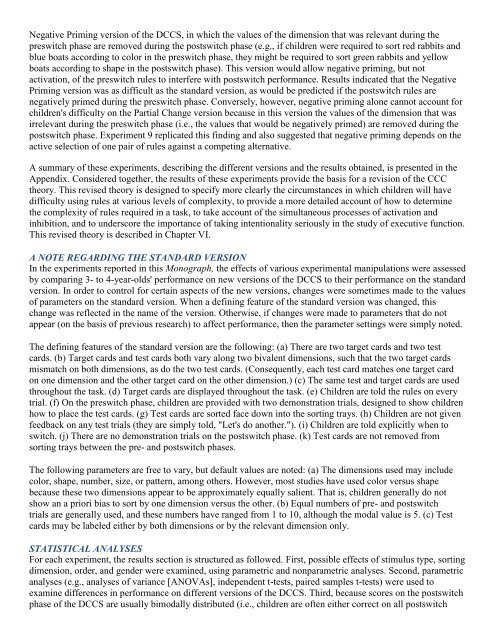THE DEVELOPMENT OF EXECUTIVE FUNCTION IN EARLY ...
THE DEVELOPMENT OF EXECUTIVE FUNCTION IN EARLY ...
THE DEVELOPMENT OF EXECUTIVE FUNCTION IN EARLY ...
You also want an ePaper? Increase the reach of your titles
YUMPU automatically turns print PDFs into web optimized ePapers that Google loves.
Negative Priming version of the DCCS, in which the values of the dimension that was relevant during the<br />
preswitch phase are removed during the postswitch phase (e.g., if children were required to sort red rabbits and<br />
blue boats according to color in the preswitch phase, they might be required to sort green rabbits and yellow<br />
boats according to shape in the postswitch phase). This version would allow negative priming, but not<br />
activation, of the preswitch rules to interfere with postswitch performance. Results indicated that the Negative<br />
Priming version was as difficult as the standard version, as would be predicted if the postswitch rules are<br />
negatively primed during the preswitch phase. Conversely, however, negative priming alone cannot account for<br />
children's difficulty on the Partial Change version because in this version the values of the dimension that was<br />
irrelevant during the preswitch phase (i.e., the values that would be negatively primed) are removed during the<br />
postswitch phase. Experiment 9 replicated this finding and also suggested that negative priming depends on the<br />
active selection of one pair of rules against a competing alternative.<br />
A summary of these experiments, describing the different versions and the results obtained, is presented in the<br />
Appendix. Considered together, the results of these experiments provide the basis for a revision of the CCC<br />
theory. This revised theory is designed to specify more clearly the circumstances in which children will have<br />
difficulty using rules at various levels of complexity, to provide a more detailed account of how to determine<br />
the complexity of rules required in a task, to take account of the simultaneous processes of activation and<br />
inhibition, and to underscore the importance of taking intentionality seriously in the study of executive function.<br />
This revised theory is described in Chapter VI.<br />
A NOTE REGARD<strong>IN</strong>G <strong>THE</strong> STANDARD VERSION<br />
In the experiments reported in this Monograph, the effects of various experimental manipulations were assessed<br />
by comparing 3- to 4-year-olds' performance on new versions of the DCCS to their performance on the standard<br />
version. In order to control for certain aspects of the new versions, changes were sometimes made to the values<br />
of parameters on the standard version. When a defining feature of the standard version was changed, this<br />
change was reflected in the name of the version. Otherwise, if changes were made to parameters that do not<br />
appear (on the basis of previous research) to affect performance, then the parameter settings were simply noted.<br />
The defining features of the standard version are the following: (a) There are two target cards and two test<br />
cards. (b) Target cards and test cards both vary along two bivalent dimensions, such that the two target cards<br />
mismatch on both dimensions, as do the two test cards. (Consequently, each test card matches one target card<br />
on one dimension and the other target card on the other dimension.) (c) The same test and target cards are used<br />
throughout the task. (d) Target cards are displayed throughout the task. (e) Children are told the rules on every<br />
trial. (f) On the preswitch phase, children are provided with two demonstration trials, designed to show children<br />
how to place the test cards. (g) Test cards are sorted face down into the sorting trays. (h) Children are not given<br />
feedback on any test trials (they are simply told, "Let's do another."). (i) Children are told explicitly when to<br />
switch. (j) There are no demonstration trials on the postswitch phase. (k) Test cards are not removed from<br />
sorting trays between the pre- and postswitch phases.<br />
The following parameters are free to vary, but default values are noted: (a) The dimensions used may include<br />
color, shape, number, size, or pattern, among others. However, most studies have used color versus shape<br />
because these two dimensions appear to be approximately equally salient. That is, children generally do not<br />
show an a priori bias to sort by one dimension versus the other. (b) Equal numbers of pre- and postswitch<br />
trials are generally used, and these numbers have ranged from 1 to 10, although the modal value is 5. (c) Test<br />
cards may be labeled either by both dimensions or by the relevant dimension only.<br />
STATISTICAL ANALYSES<br />
For each experiment, the results section is structured as followed. First, possible effects of stimulus type, sorting<br />
dimension, order, and gender were examined, using parametric and nonparametric analyses. Second, parametric<br />
analyses (e.g., analyses of variance [ANOVAs], independent t-tests, paired samples t-tests) were used to<br />
examine differences in performance on different versions of the DCCS. Third, because scores on the postswitch<br />
phase of the DCCS are usually bimodally distributed (i.e., children are often either correct on all postswitch
















